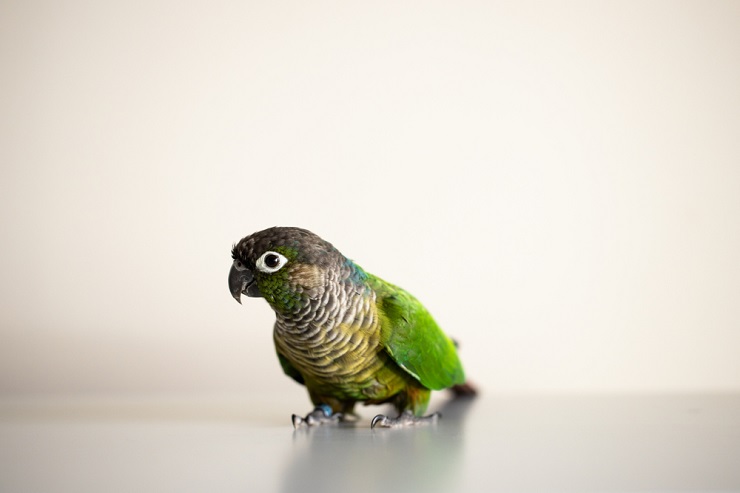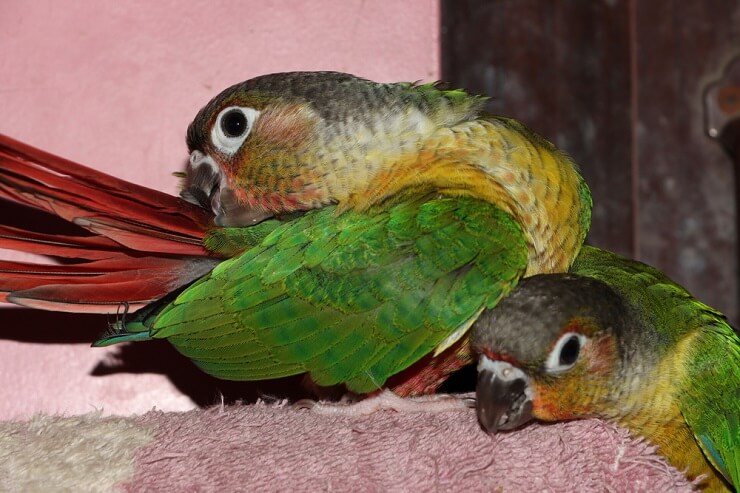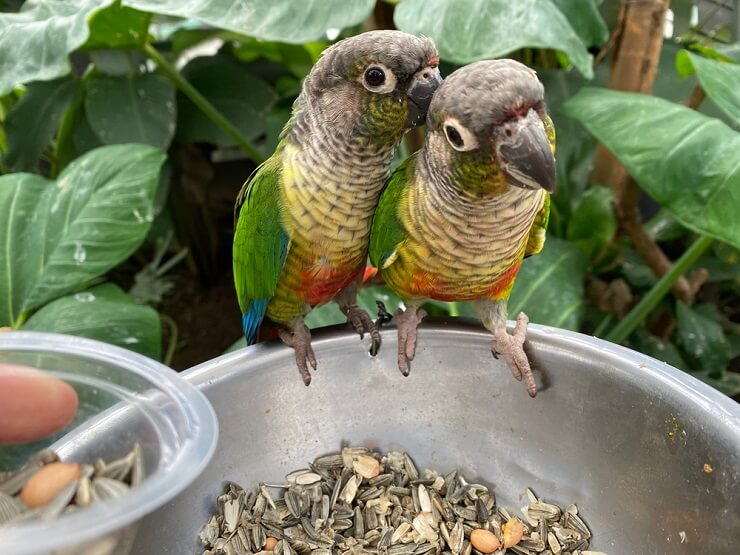Green-Cheeked Conure: Personality, Care And Nutrition
This page contains affiliate links. We may earn money or products from the companies mentioned in this post through our independently chosen links, which earn us a commission. Learn More
The small size, quiet but engaging nature and beautiful plumage make the green-cheeked conure a popular pet. Originally native to South.
America, they have become common household pets across the world. Known also as the green-cheeked parakeet, they are one of the smaller conure species, at only around 10 inches in length and weighing in at around 2-3 ounces. They are curious and playful, making for fun companions.
Green-cheeked conures are monomorphic (males and females look exactly alike) and are very colourful. As the name suggests, they have olive green cheeks, with similar coloured feathers surrounding a red patch on their chests, with grey barring. Their backs and tops of the wings are a resounding bright green. They have bright red tail feathers and black on the head. They are often confused with the maroon-bellied conure, as they look similar and are closely related.
Personality

These conures are very sociable, and thrive on time spent with their owners. Known to be affectionate and easy-going, they are popular pets. Comic and mischievous, they are known for their clowning around, and like to hang upside down on the cage bars, asking for attention.
They are intelligent and love to do tricks, and are very rewarding to train. Get started with some simple tricks here. They are not big talkers, and some never learn any words, although a few will master some basics. They can still be noisy though, with all the squawks and squeaks that come with owning a pet bird.
Green-cheeked conures are small and good-natured, with aggression being rare, so can be a good pet bird to own if there are children in the household. Always provide supervision, and remember that all birds can nip, even those as friendly as the green-cheeked conure.
Care

As one of the smaller species, these conures don’t need quite so large an enclosure as some large parrot species, but they do still need plenty of space. Suitable cages must be at least 24 inches wide and 30 inches high, although the larger the enclosure the better. There are some excellent options for cages here.
Perches should be provided in a variety of sizes and materials, to keep your bird’s feet limber and healthy. The cage floor should be cleaned regularly. Provide a water dish that is large enough for them to bathe in if they wish.
In the wild, green-cheeked conures live in flocks and are very sociable. As pets, they do well with other green-cheeked conures, but not with other bird species. Remember, if you have more than one bird, you will need a much larger enclosure. These birds require plenty of social interaction and should have 3-4 hours a day of time outside their cage to exercise and interact with you. This should be in a room that has been made safe – doors and windows should be closed, with no fans, pets or any plants that may be toxic.
It’s very important that these birds have a safe space outside the cage to exercise daily, for at least a couple of hours. A play gym in the cage, alongside things like puzzle toys, can help keep them exercised and stimulated, reducing frustration. Green-cheeked conures are intelligent and may enjoy learning some simple tricks.
Conures are good chewers, and the green-cheeked variety is no exception. Provide plenty of toys for them to chew and destroy. These will need to be cleaned regularly, and replaced as needed. Toys are really important for birds to reduce frustration which can lead to problematic behaviours. Hard-wearing toys are recommended as conures can be quite voracious chewers.
Conures can live up to thirty years in captivity, and do require a lot of time to care for properly, so as with any pet bird, are a big commitment to take on.
Nutrition

In the wild, green-cheeked conures will eat a mixture of fruits, vegetables, seeds and insects. This can be replicated in pet conures by feeding a mix of fresh fruit and vegetables daily, supplemented with a commercial pellet mixture. The pellet mix should make up around 60-70% of their diet, with the rest being fresh. Here is some information on various commercial foods for parrots. Vegetables and fruits not eaten should be discarded a few hours after they have been provided.
Fortified seeds can be given as an occasional treat, but can be very high in fat and calorie content, so should be given sparingly. Avocadoes, fruit seeds and chocolate are all highly toxic to birds and must be avoided. Conures have ‘busy beaks’ and so need plenty of foods that allow chewing and gnawing. They also remove the hulls from any seeds before eating, so they do not need to be offered grit alongside their food.
Frequently Asked Questions
Do green-cheeked conures talk?
They are not one of the big talkers in the bird world, no. Some may learn a few words but plenty will not talk at all.
Is the green-cheeked conure a good pet?
Like all bird species, green-cheeked conures require a good amount of time and care. If you are prepared to take on all the necessary care, these small birds are sociable and affectionate and make excellent pets.
Are green-cheeked conures cuddly?
Birds do vary in temperament, but green-cheeked conures are known to be easy-going and affectionate and can form very strong bonds with their owners.
Is a green-cheeked conure a good first bird?
Yes, they can be very suitable for a first bird as they are easy-going and quieter than some species, although they do require plenty of time for social interaction and exercise.
